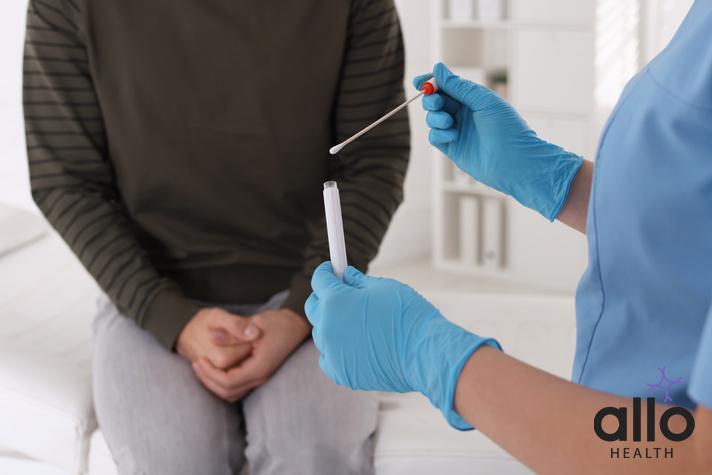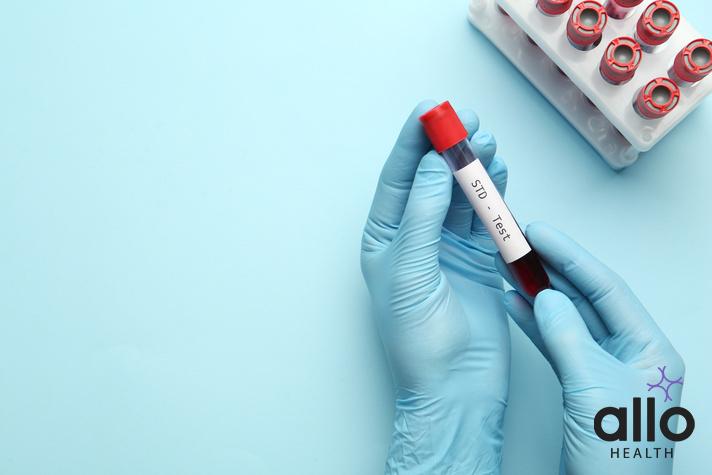Fungal STD: Symptoms, Treatment, and Prevention

Allo Health is dedicated to personalized well-being, offering support and trusted information tailored to individual health goals. The platform emphasizes human-generated content, led by a distinguished medical team of experts, including physicians and sexual health specialists. Their commitment to credibility involves rigorous fact-checking, authoritative research, and continuous updates to ensure accurate, up-to-date information. Allo Health's unique approach goes beyond conventional platforms, providing expert-led insights and a continuous commitment to excellence, with user feedback playing a crucial role in shaping the platform's authoritative voice.

Dr Sanina Mansoor holds MBBS degree from Yenepoya university,Mangalore.She has 8 years of experience working as a medical officer at various health centres and medical colleges.
Why This Was Upated?
Our experts continually monitor the health and wellness space, and we update our articles when new information became available.
Updated on 13 April, 2024
- Article was updated as part of our commitment to diversity, equity, and inclusion.

"The following blog article provides general information and insights on various topics. However, it is important to note that the information presented is not intended as professional advice in any specific field or area. The content of this blog is for general educational and informational purposes only.
Book consultation
The content should not be interpreted as endorsement, recommendation, or guarantee of any product, service, or information mentioned. Readers are solely responsible for the decisions and actions they take based on the information provided in this blog. It is essential to exercise individual judgment, critical thinking, and personal responsibility when applying or implementing any information or suggestions discussed in the blog."
In sexually transmitted diseases (STDs), there are numerous infections caused by bacteria and viruses. However, fungal STD, while less common, can also pose significant health concerns. In this comprehensive article, we will delve into the fungal STDs, exploring their symptoms, causes, treatment options, and prevention methods.
What are Fungal STDs?
Fungal STD, or sexually transmitted diseases caused by fungi, are less common than bacterial or viral STDs but can still impact one’s health. These infections are typically transmitted through sexual contact, and there are several types of fungal STDs to be aware of:
- Vaginal Candidiasis (Vaginal Yeast Infection): This is the most common fungal STD in women, characterized by symptoms like vaginal itching, abnormal discharge, pain during intercourse, and foul-smelling discharge.
- Tinea Pedis (Athlete’s Foot): Although commonly associated with the feet, it can spread to the groin through sexual contact. Symptoms include itchy, red skin, peeling, and discomfort.
- Jock Itch: Also known as tinea cruris, this affects the groin area in both men and women, leading to an itchy, red rash, painful urination, and skin discomfort.
- Fungal Skin Infections: These can manifest as rashes and itching in various body areas, including the genitals, due to fungal growth.
- Candida Yeasts: These yeasts can cause oral thrush, affecting the mouth and throat, and genital candidiasis, impacting both men and women.
Fungal STDs are typically treatable with antifungal medications. However, proper diagnosis by a healthcare provider is crucial. Preventative measures include practicing good hygiene, using protection during sexual intercourse, avoiding tight clothing in damp conditions, and staying informed about these infections to protect one’s sexual health.
Symptoms of Fungal STD
Fungal STDs can manifest with various symptoms and recognizing them is crucial for early diagnosis and treatment. Here are the common symptoms associated with these infections:
Vaginal Candidiasis (Vaginal Yeast Infection):
- Vaginal itching and discomfort, often accompanied by extreme itch (pruritus).
- Abnormal vaginal discharge, which may appear white, thick, and cottage cheese-like.
- Pain during sexual intercourse (dyspareunia) and urination (dysuria).
- Foul-smelling discharge, a distinct sign of infection.
Tinea Pedis (Athlete’s Foot):
- Itchy, red, and inflamed skin on the feet, particularly between the toes.
- Peeling and flaking of the skin, lead to a chronic rash.
- Burning sensation and discomfort, especially when wearing tight-fitting shoes or damp socks.
Jock Itch:
- Itchy, red rash in the groin area, often spreading to the inner thighs.
- Painful urination (dysuria) if the rash extends to the genital area.
- Skin discomfort, including a strong itching sensation.
It’s important to note that some fungal STDs, like vaginal candidiasis, share symptoms with other conditions, such as bacterial vaginosis or urinary tract infections. If you experience these symptoms, especially if you’ve engaged in sexual activities or have been in direct contact with an infected person, it is advisable to consult a healthcare provider for accurate diagnosis and appropriate antifungal treatment. Early detection and treatment are crucial to eliminate the infection and prevent further complications.
Causes and Transmission

Fungal STD, caused by various fungi, have specific causes and modes of transmission. Understanding these factors is crucial in preventing their spread:
- Sexual Contact: Fungal STDs are primarily transmitted through sexual activities, including vaginal, anal, and oral intercourse. This direct contact with an infected person’s bodily fluids can lead to infection, making proper protection, such as condoms, essential in reducing transmission rates.
- Poor Hygiene: Inadequate personal hygiene can contribute to the development and transmission of fungal STD. Basic hygiene practices, like regular bathing and proper cleansing of genital areas, can help prevent infections.
- Moist Environments: Fungi thrive in damp environments, making moisture a contributing factor for yeast infections like vaginal candidiasis. Individuals should avoid wearing damp or tight-fitting clothing to reduce the risk of infection.
- Contact with Contaminated Objects: Fungal infections can spread through contact with contaminated objects such as towels, clothing, or shared personal items. Athlete’s foot (tinea pedis) is a common example of this mode of transmission.
- Infected Persons: Sexual partners of an infected person are at higher risk. Prompt treatment of fungal STDs and communication with sexual partners are critical to preventing further transmission.
- Environmental Factors: Environmental diseases like jock itch can be caused by fungi present in the environment. Maintaining cleanliness in shared spaces like locker rooms is essential.
Fungal STDs are typically transmitted through sexual contact and can be exacerbated by factors like poor hygiene, moist environments, and contact with contaminated objects. Practicing safe sex, maintaining good personal hygiene, and being cautious in shared spaces can help reduce the risk of these infections.
Diagnosing Fungal STDs

Diagnosing fungal STD involves a combination of medical examination and specific tests to confirm the presence of these infections. Here are the key diagnosis methods:
- Physical Examination: Healthcare providers conduct a physical examination to assess the affected area, looking for common symptoms like redness, itching, or rashes. This examination can help identify conditions like vaginal candidiasis, tinea pedis, or jock itch.
- Blood Tests: In some cases, blood tests may be performed to detect fungal infections, especially when dealing with chronic forms of these STDs or when assessing the possibility of other venereal diseases. Blood tests can also help in ruling out hepatitis or syphilis infections, which may have distinct symptoms.
- Cultures and Swabs: Swabs may be taken from the genital area or affected skin to culture the fungus, allowing healthcare providers to identify the specific type of fungi causing the infection. This method aids in accurate diagnosis and tailored treatment.
- Follow-Up Tests: After initial treatment, follow-up tests may be conducted to ensure the elimination of the infection. It’s crucial to monitor the progress of treatment, especially for chronic or severe infections.
- Pelvic Exam: For vaginal fungal infections, a pelvic exam may be performed to examine the cervix for signs of infection or abnormalities, aiding in the diagnosis of vaginal candidiasis.
Diagnosing fungal STDs involves a thorough examination of physical symptoms, along with specific tests such as blood tests, cultures, swabs, and pelvic exams when necessary. Seeking prompt medical attention and accurate diagnosis is essential for effective treatment and prevention of complications.
Treatment Options
Treatment options for fungal STDs vary depending on the specific infection and its severity. Here are the different methods of treating fungal STDs:
- Antifungal Medications: Antifungal drugs are the primary treatment for fungal STDs. These medications can be administered through various forms, including:
- Topical Antifungal Creams: These are applied directly to the affected area, making them suitable for mild to moderate infections like vaginal candidiasis (vaginal yeast infection) and jock itch.
- Oral Medications: In cases of severe infections or when topical treatments prove insufficient, healthcare providers may prescribe oral antifungal medications. This is common for conditions like tinea pedis (athlete’s foot).
- Prescription Medications: For chronic or recurrent infections, stronger prescription antifungal medications may be required. These medications are typically administered under the guidance of a healthcare provider.
- Follow-Up Tests: After completing a course of antifungal treatment, follow-up tests may be necessary to ensure the elimination of the infection and rule out any complications.
- Symptom Management: Over-the-counter medications such as pain relievers may help manage symptoms like itching or discomfort while undergoing treatment.
Remember, the choice of treatment will depend on the specific fungal STD, its severity, and the recommendation of your healthcare provider. Timely and accurate treatment is essential for effectively addressing these infections and minimizing complications.
Preventing Fungal STD
Preventing fungal STDs is crucial for maintaining sexual health. By following these preventive measures, individuals can reduce their risk of contracting fungal STDs and related infections:
- Safe Sexual Practices: Always use condoms during sexual intercourse to minimize the risk of direct contact with an infected person’s bodily fluids, a common mode of transmission for fungal STDs.
- Proper Hygiene: Maintain basic hygiene practices by regularly cleaning genital areas. Avoid damp or tight-fitting clothing, as these factors contribute to the growth of fungi.
- Limit Sexual Partners: Reducing the number of sexual partners and choosing partners carefully can lower the likelihood of exposure to fungal STDs.
- Education: Educate yourself and your sexual partners about fungal STDs, their common symptoms, and transmission modes. Knowledge is a powerful tool in disease prevention.
- Avoidance of Drug Abuse: Substance abuse can weaken the immune system, making individuals more susceptible to infections, including fungal STDs.
- Regular Health Check-ups: Visit a healthcare provider for regular check-ups and screenings, especially if you engage in sexual activities with multiple partners or experience symptoms of fungal infections.
- Environmental Awareness: Be cautious when sharing personal items like towels or clothing, as they can harbor fungal spores and transmit infections.
- Prompt Treatment: If you suspect you have a fungal STD or notice symptoms like itching, discharge, or rashes, seek immediate medical attention. Early diagnosis and accurate treatment with antifungal medications are key to preventing the spread of these infections.
By adhering to these preventive measures and maintaining awareness of fungal STDs, individuals can significantly reduce their risk of infection and promote overall sexual health.
Conclusion
Fungal STDs may not be as prevalent as bacterial or viral STDs, but they still pose significant health risks. Recognizing the symptoms, seeking prompt medical attention, and practicing safe sex are essential steps in preventing and managing these infections. Remember that your healthcare provider is your best resource for accurate diagnosis and treatment of fungal STDs. Stay informed, stay safe, and prioritize your sexual health.
Most Asked Questions
-
What are fungal STDs, and how do they spread?
Fungal STDs are infections caused by fungi that can be passed from one person to another during sexual contact. They can also spread through damp or tight-fitting clothes and poor hygiene.
-
Are fungal STDs treatable, and what are the treatment options?
Yes, fungal STDs are treatable with antifungal medications. Treatment can include topical creams, oral medications, or stronger prescriptions if needed. If you suspect an infection, consult a healthcare provider for the right treatment.






































